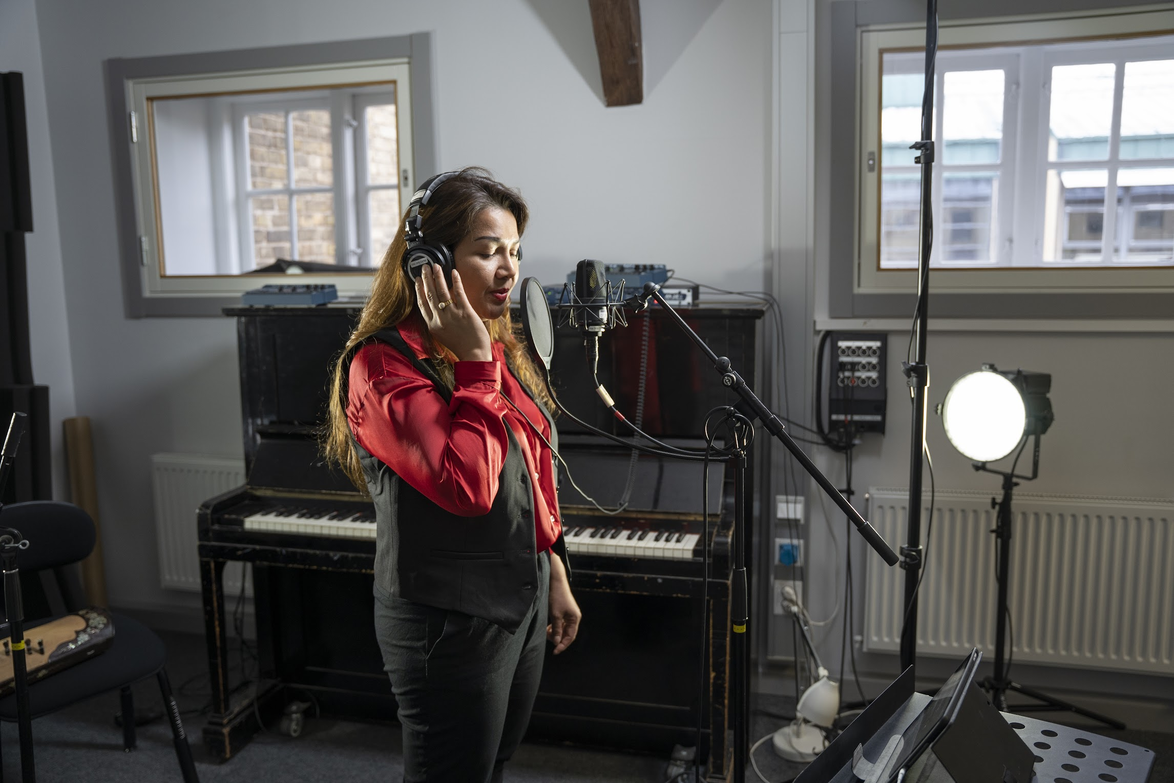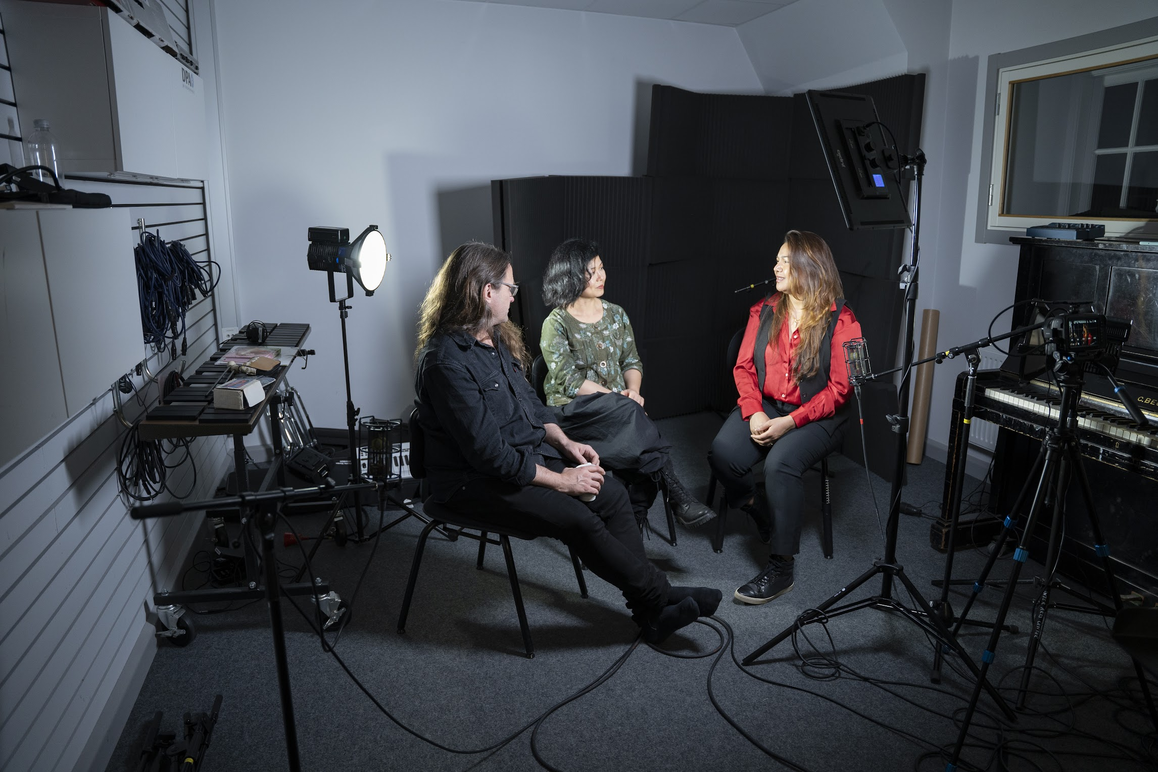The video essay Echoic Memory contains footage from zoom interviews with thirteen Vietnamese women living in diaspora. It was made in spring 2021, during the Covid-19 pandemic, and features an experimental recording of the song Phôi Pha7 by The Six Tones with the singer Ngô Hồng Gấm8 and a solo đàn tranh version by Nguyễn Thanh Thủy of the song Còn Thương Rau Đắng Mọc Sau Hè.9 In this video essay we encounter first- and second-generation women of both voluntary and forced immigrants from Vietnam. The video is structured on a thematic analysis of the interviews, generating a three-part narrative: The role of music in the lives of these women; their journeys from Vietnam; and of identity formation in diaspora.
The video essay The Sorrow Turns Yellow provides a brief history of Vietnamese popular music and connects it to the hybrid culture of South Vietnam in the colonial days. One example of colonial influence is the use of Western tonal harmony in Vietnamese popular music (Henry, 2005; Gibbs, 2003). The video includes an analysis of the solo đàn tranh version of the song Còn Thương Rau Đắng Mọc Sau Hè with reference to two historical recordings of the song, the first recorded in Sài Gòn in 1974 and the second recorded in Paris in 1988. In order to overrule the tonal structures which are characteristic of nhạc vàng songs, Nguyễn Thanh Thủy approached the melodic material through the modal and heterophonic structuring principles of traditional Vietnamese music. With reference to the Southern genre of Nhạc Tài Tử10 and using the Ai-Oán11 mode, the version for đàn tranh solo also became a test of an artistic method for the continued work of The Six Tones, in the creation of experimental versions of nhạc vàng.
There certainly are great differences between the typical expressive qualities of nhạc vàng and the range of expression in traditional music of Vietnam. On the one hand, in traditional music, the expression is most of all defined by the mode, and by the ornamentation prescribed by the tradition. Taking the Southern tradition of Nhạc Tài Tử as an example, a performer will seek to achieve Mùi, a quality of performance which combines expressive ornamentation and a smooth design of melodic lines. On the other hand, in nhạc vàng tonal harmony defines much of the expression, while melodic lines and vocal expressive means may still retain qualities from traditional music. At the same time, these modes of expression have not always been transmitted to the second Vietnamese generation we encounter in the interviews, as described by Huỳnh Phi Thuyền—a Vietnamese who lives in Norway—who tried to teach her son to play the đàn tranh. She would spend a lot of time explaining how the music works and how its expression should be achieved, but to him “it was only words”, since he had not himself experienced the music (Video essay Echoic Memory at 15:53). Similarly, Anna Linh Nguyễn Berg—a second generation Vietnamese woman in Norway—describes how, even though she always heard Vietnamese music at home, and they always had only Vietnamese food, such a local transmission of tradition from the family alone doesn’t always reach all the way when growing up in a different cultural environment. She describes her own impression of being “not 100% of anything”, hereby articulating an awareness of developing a hybrid identity (Video essay Echoic Memory at 16:28). In the video essay The Sorrow Turns Yellow (at 03:56), Lâm Mỹ Lệ expresses a related impression of identity, of being half Danish, half Vietnamese. But for her as a first-generation immigrant, the experience of singing nhạc vàng is always that of, as it were, becoming Vietnamese, of confirming her belonging to her home culture.
Following the economic reforms and the gradual openness to foreign influence and international exchange, composers and performers of experimental music began to be introduced in Vietnam in the 1990s. In the early 2000s, several younger Vietnamese composers received DAAD15 scholarships to study in Germany, bringing further knowledge and experience back to the emerging scene for contemporary and experimental music in Hà Nội (Östersjö & Nguyễn, 2021). Although most of the interviewees were obviously not aware of such a music scene in Vietnam, Tôn Nữ Quỳnh Chi mentions how, as a second-generation Vietnamese in Norway, she feels a need to know more about her culture: “Therefore, I want to bring Vietnamese music and culture over here, to introduce our modern, contemporary Vietnamese music, or the traditional…” (Video essay Echoic Memory at 14:47). It is important also to mention that a major Norwegian music festival has given her the opportunity to carry out such exchanges. If the nostalgia of the karaoke culture in restaurants in Orange County, California, had its origins in the limited opportunities among the first generation of Vietnamese immigrants for exchange with a cultural scene in their homeland (Wong & Elliot, 1994), this situation is changing, and the contemporary music scene in Vietnam has increasing possibilities for interaction with Vietnamese diasporic audiences.
As an intercultural music group, The Six Tones have developed a way to associate traditional music with contemporary soundscapes using signal processing as well as different forms of free improvisation. In the video essays, we see several examples of how the group has sought to create methods to experiment with nhạc vàng in similar ways, with the aim of opening this musical heritage to new interpretations, and potentially new expressive qualities. Perhaps such a musical practice may form part of a widening set of musical possibilities for Vietnamese in diaspora to connect with the music of their homeland, not only through nostalgic longing, but also by engaging in many different forms of musical expressions, enabled by transnational and intercultural exchange. The interview with Anna Linh Nguyễn Berg provides an example of such a re-negotiation of identity, in her case, sparked by her curiosity about Vietnamese traditional music.
References
Akman, Haci, ed. “Negotiating Identity in Scandinavia: Women, Migration and the Diaspora.” New York & Oxford: Berghahn Books, 2014.
Cunningham, Stuart, and Tina Nguyen. “Popular Media of the Vietnamese Diaspora.” Javnost - The Public 6, no. 1 (1999): 71-92.
DeWald, Erich. “Taking to the waves: Vietnamese society around the radio in the 1930s.” Modern Asian Studies 46, no.1 (2012): 143-165.
Gibbs, Jason. “The West’s Songs, Our Songs: The Introduction and Adaptation of Western Popular Song in Vietnam before 1940.” Asian Music 35, no. 1 (2003): 57-83.
Henry, Eric. “Tân Nhạc: Notes Toward a Social History of Vietnamese Music in the Twentieth Century.” Michigan Quarterly Review 44, no. 1 (2005): 135-147.
Lutz, Helma. “Gender in the Migratory Process.” Journal of Ethnic and Migration Studies 36, no.10 (2010): 1647-1663.
Morokvaśic, Mirjana. “The overview: birds of passage are also women.” International Migration Review 68, no. 18 (1984): 886-907.
Nguyễn, Thanh-Thủy. “The Choreography of Gender in Traditional Vietnamese Music.” (PhD diss., Lund University, 2019) https://doi.org/10.22501/rc.55919
Norton, Barley. “Songs for the spirits:music and mediums in modern Vietnam.” University of Illinois Press, 2009.
Olsen, Dale A. “Popular Music of Vietnam: The Politics of Remembering, the Economics of Forgetting.” Routledge Studies in Ethnomusicology, 2008.
Ó Briain, Lonán. “Voices of Vietnam: a century of radio, red music, and revolution.” Oxford University Press, 2021.
Östersjö, Stefan and Nguyễn Thanh-Thủy. “Attentive listening in lo-fi soundscapes: Some notes on the development of sound art methodologies in Vietnam.” In The Bloomsbury Handbook of Sonic Methodologies, edited by Michael Bull and Marcel Cobussen, 481-495. London: Bloomsbury, 2021.
Reyes, Adelaida. “Songs of the Caged, Songs of the Free: Music and the Vietnamese Refugee Experience.” Philadelphia: Temple University Press, 1999.
Tam, Kỳ. “Con gái nhạc sĩ Bắc Sơn hát tưởng nhớ cha.” Vnexpress, 26 February, 2021. https://vnexpress.net/con-gai-nhac-si-bac-son-hat-tuong-nho-cha-4240699.html
Taylor, Philip. “Fragments of the Present: Searching for Modernity in Vietnam’s South.” ASAA Southeast Asia Publications Series: Australia, 2001.
UNHCR. “Henning Becker v. Denmark.” Refworld, 3 October, 1975. https://www.refworld.org/cases,COECOMMHR,3ae6b7058.html
Valverde, Kieu-Linh Caroline. “Making Vietnamese Music Transnational: Sounds of Home, Resistance and Change.” Amerasia Journal 29, no. 1 (2003): 29-49.
Wong, Deborah, and Mai Elliot. “‘I Want the Microphone’: Mass Mediation and Agency in Asian-American Popular Music.” TDR (1988-) 38, no. 3 (1994): 152-67. https://doi.org/10.2307/1146384.
The history of nhạc vàng in Vietnam is immediately connected to the impact of colonisation. As a result of the hybrid culture in colonial Vietnam, popular songs with influence from Western music emerged in the late 19th century (Gibbs, 2003; Henry, 2005). Here, radio stations both in Sài Gòn and Hà Nội became important exponents, both for French and American music, as well as for the new Vietnamese music (DeWald, 2012; Ó Briain, 2021). As described by Olsen (2008): in the early 20th Century “French colonial period dance bands were common in urban areas, as they provided entertainment for the French and Vietnamese elite, and American-style Vietnamese rock bands were popular during the American War as entertainment for American soldiers” (p. 95). Such bands also contributed to developing the sound of nhạc vàng as the record industry in the south of Vietnam kept thriving in the colonial metropolis of Sài Gòn, all the way up to the end of the war in 1975.
Although the clash between the “revolutionary” culture of the North and the colonial culture of the South—between the anti-colonialist songs promoted as red music by the Northern government and what has come to be called yellow music of the South—was strong during the war, the contrasting rule systems were further enhanced in the post-war period. In a series of publications, the official definition of yellow music was established. In the very first of these, the composer/researcher Tô Vũ defined yellow music as a cultural expression that evoked “in hapless listeners a gloomy, embittered, impotent and cynical mood towards life, an attitude negating youth’s desire to be cheerful, a sensation of being drowned in loneliness in a withered and desolate world” (Tô Vũ cited in Taylor, 2001, p. 43).
This exposition seeks to identify artistic strategies and challenges in intercultural experimentation with nhạc vàng (yellow music)—a Vietnamese popular music genre. It builds on the author’s experience as a professional đàn tranh player on the Vietnamese traditional music scene,1 and on her long-term international collaboration with performers and composers, as a member of the Vietnamese/Swedish group The Six Tones.2 In three video essays, the exposition presents the artistic process developed by the participating artists, and an analysis of how these strategies relate to the rule systems of traditional and popular music in Vietnam.
The work has been carried out as part of the postdoctoral artistic research project “Music and Identity in Diaspora: novel perspectives on female Vietnamese immigrants in Scandinavia”.3 The purpose of the project is to determine how music contributes to identity formation among Vietnamese immigrants, with a particular focus on the role of different musical traditions in this context. The aims of the postdoctoral project are (a) to provide a more robust understanding of how music contributes to identity and social cohesion in immigrant communities; (b) to identify patterns of gendered behaviour in immigrant communities across generations; and (c) to develop effective strategies—including experimental music practices and other artistic expressions—that promote reduction of social inequalities among immigrant communities.
There are several important studies about the role of music among Vietnamese immigrants (Cunningham & Nguyen, 1999; Reyes, 1999), but no Scandinavian study. In a study of the role of music and media in the formation of cultural identity among Vietnamese immigrants in Australia, Cunningham and Nguyen (1999) note “the felt need to maintain pre-revolutionary Vietnamese heritage and traditions; find a negotiated place within a more mainstreamed culture; or engage in the formation of distinct hybrid identities around the appropriation of dominant Western popular cultural forms” (p. 77). The present exposition contributes with new knowledge to the study of music and migration by studying Vietnamese immigrant communities from the Vietnamese women’s perspective.4
Stefan Östersjö, Nguyễn Thanh Thủy and Lâm Mỹ Lệ
Inter Arts Center Studio, Malmö, Sweden
Photo: Ludvig Östersjö
After the Fall of Saigon in 1975, that marked the end of the Vietnam war, many sentimental pop songs, labelled as yellow music, were banned by the Vietnamese communist party. However, the ban failed to achieve its aims since the music continued to be secretly performed and listened to within the country. Furthermore, refugees from Vietnam brought this music with them and created a successful overseas Vietnamese music industry, first in France and in the US. Eventually the music also reached communities of Vietnamese immigrants all around the world. Since Đổi Mới—the economic reforms initiated in Vietnam in 1986—and the gradual opening of the country, many musicians have returned for tours of Vietnam, bringing the previously banned music to even larger audiences.5
Reyes (1999) attributes the popularity of nhạc vàng songs in the exiled Vietnamese community to a wish to preserve a culture that was shattered to pieces in the post 1975 diaspora, and further, that the continued performance of this music was perceived as an act of resistance. Valverde (2003) argues that this strong political motivation also limited exiled Vietnamese artists from creating something new, and that the strife for preservation was becoming a “culture in a bubble” (p. 32). While returning to the pre-1975 repertoire, and exploring the characteristic style of the record production, The Six Tones challenge the rule systems of nhạc vàng, and seek to break this cultural bubble, with the aim of reviving this cultural heritage, and also to fill it with new meaning for new generations of overseas Vietnamese.
The three video essays address this aim in different ways. They are built on analyses of the process of creating three recordings6 by The Six Tones and Ngô Hồng Gấm and Lâm Mỹ Lệ, two Vietnamese singers living in Australia and Denmark. The video essays also include interviews with other female immigrants in the Nordic countries. Two of the three songs were chosen by the two singers. The third song was first introduced to Thủy during an interview with Nguyễn Ngọc Diệp, a Vietnamese who lives in Sweden.
During spring 2021 and spring 2022, Nguyễn Thanh Thủy conducted online and in-person interviews with Vietnamese women living in diaspora, most of them in Scandinavia. The interviewees were contacted on Facebook, often on a suggestion from a previous informant or from diasporic Vietnamese friends of Nguyễn. They were not selected using any pre-conceived criteria, apart from being of Vietnamese heritage. The way the women in the interviews describe the role of music in their everyday lives is indeed manifold, and often connected to singing. Most of the interviewees express an active engagement with music, and almost exclusively with Vietnamese music. While some either sing or play traditional music, most of the women refer to nhạc vàng as the music they sing or listen to in their daily life. Several studies have pointed to the central role of nhạc vàng among overseas Vietnamese (Reyes, 1999; Valverde, 2003) and it seems that the tendency is the same in Scandinavia. It is not possible to discuss the role of singing, and of popular music, in Vietnamese culture without also looking at the role of karaoke. As described by Barley Norton (2010), ever since the 1990’s “the sound of amplified voices, with heavy reverb added, drifting above synthesizer backing tracks of karaoke discs was a ubiquitous feature” of the soundscape of any Vietnamese town or city (p. 152). But, in a very different and more discreet way, karaoke has also become a central feature of Vietnamese identity in diaspora (Wong & Elliot, 1994).
The video essay The (re)Turn analyzes the process of creating an experimental version of the song Yêu Một Mình12 by The Six Tones in collaboration with the singer Lâm Mỹ Lệ13 and the turntablist and improviser Matt Wright.14 The process of reduction, described in the video essay The Sorrow Turns Yellow, was also used here. The principle was to reduce the song to a melodic framework. This made it possible to apply traditional modal principles for improvisation. However, when a structural framework had been established, other approaches to improvisation were also introduced, drawing on the intercultural and experimental practice of The Six Tones. In this video essay, the technologies used in performance and post-production are introduced. The video essay also describes how these technologies enabled the group to reconnect to the original pre-1975 sound of nhạc vàng, with particular reference to a recording produced in 1972 in Sài Gòn with the singer Dạ Hương and the Shotguns.










